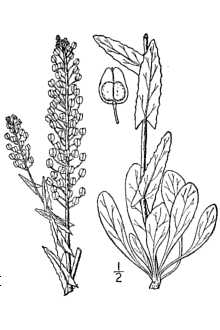- Lepidium campestre
taxobox
name = Field pepperweed
regnum =Plantae
unranked_divisio =Angiosperms
unranked_classis =Eudicots
unranked_ordo =Rosids
ordo =Brassicales
familia =Brassicaceae
genus = "Lepidium "
species = "L. campestre"
binomial = "Lepidium campestre"
binomial_authority = L.|"Lepidium campestre", or Field pepperweed is an
annual plant in theBrassicaceae or mustard family, native toEurope , but commonly found inNorth America as an invasiveweed . The most notable characteristic of field pepperweed are itsracemes which fork off of the stem. These racemes are made up of first small white flowers and later green, flat and oval seedpods each about 6 mm long and 4 mm wide.Richard H. Uva, Joseph C. Neal and Joseph M. Ditomaso, "Weeds of The Northeast", (Ithaca, NY: Cornell University Press, 1997), Pp. 176-177.] Each seedpod contains two brown, 2.5 mm long seeds.The stem of field pepperweed comes out of a
basal rosette of toothed leaves. The stem is covered in leaves, which aresessile , alternate and arrow-shaped. The entire plant is generally between 20 and 60 cm tall and covered in small hairs.Cultivation and uses
Field pepperweed grows in disturbed land, crops, and waste places. It can tolerate most soils. It is found throughout North America, but grows the most abundantly in the Northeast to the north Midwest.
The young leaves can be added directly to
salads , or boiled for ten minutes.Lee Allen Peterson, "Edible Wild Plants," (New York City: Houghton Mifflin Company, 1977), p. 26.] The young seedpods can be used as a spice, with a taste betweenblack pepper and mustard. The leaves containprotein ,vitamin A andvitamin C .References
Wikimedia Foundation. 2010.
